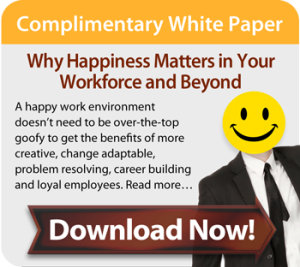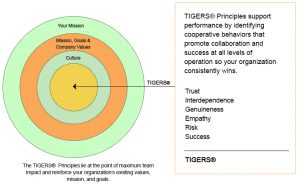 Which comes first, a positive work culture or happy employees?
Which comes first, a positive work culture or happy employees?
Experts find that promoting employee happiness benefits everyone. This includes both employees and executives.
Happiness, however, is similar to motivation. It is intrinsic. This means that happiness, at the deepest levels, comes from conditions that support you.
Here are some examples:
- Relatedness: Does your work culture strengthen relationships? Does it support you in giving to your work community?
- Autonomy: Does your work culture spark a passion of yours? Does it reflect your own nature and personal core values?
- Competence: Does your work culture support personal growth? Can you get better at something? Can you learn new skills? Can you learn from your experience?
Unless you’re some enlightened human being that can generate happiness in the face of adversity, you wear down. Then your choices are to leave or disengage.
So to answer the question what comes first – a positive work culture or happy employees – work culture is it. Work culture and the behaviors that support it can produce misery, boredom or happiness by how employees feel a sense of relatedness, autonomy and competence.
So why don’t more employers and CEOs focus on happiness? Perhaps, there’s more than one way to improve employee engagement if the concept of happiness is hard to wrap your mind around.
When you explore happiness, you ultimately compel quality employees to stay. You also attract new employees that want to experience the positive work culture you have developed. If you’re not sure how to drive positive work culture, where can you start.
A positive work culture builds your bottom line.
The environment you work in plays a huge role in sustainable employee engagement and productivity. Employees who are happy and feel secure in their jobs perform 20 percent better than other employees. This spike in productivity rescues a wobbling bottom line. It saves you money on its own when you put forth the effort.
However, this means that building a positive work culture takes more than benefits and goodies. These are extrinsic perks that other organizations provide as well. It is your work culture that differentiates your company from others. For example, perks and benefits don’t really make a huge difference when you have a high turnover. High turnover impacts your bottom line like a weed whacker.
While work environments do benefit from aesthetics, a positive work culture also depends on the behavior of every worker and leader. When visible behaviors support trust, interdependence, empathy, risk resolution and success, relatedness, autonomy and competence are outcomes. These six principles are easy to remember by the acronym TIGERS®. They also promote high performance teams and departments that are much more productive while saving on costs, too.
 Are employees really that unhappy at their jobs without a positive work culture?
Are employees really that unhappy at their jobs without a positive work culture?
It’s actually hard to keep employee engagement for a long period of time. This is partly because employees are never fully satisfied with their jobs. The Pew Research Center found that Millennials are the ones leading the job force right now–and some experts say that they switch their jobs at least every two years. One LinkedIn study found that Millennials job hop more than their predecessors.
The truth of the matter is that Millennials are not job hoppers when their work culture gives them relatedness, autonomy and opportunities to pursue competence. For them, there needs to be a reason to get up and go to work every day. If they don’t like it, they won’t be productive. Eventually, they leave. The hard cold truth is that Millennial job hopping is not about them. It is your work culture that discourages talented people to stay.
With the Baby Boomer generation leaving the job force now in record numbers, keeping the employees you have is critical for organizations. It doesn’t take much to retain them when your work culture is positive.
Why employees need positive work culture through permanent vivid workplace design.
A global study found that 17 of the world’s biggest economies have disengaged workers. The study also found a correlation between employee engagement and workplace satisfaction.
Basically, when employees have more control over their physical workplace, it increases their productivity and workplace satisfaction. Providing comfort for those who are helping you promotes productivity.
Examples include:
- Paying attention to what teams need in order to succeed. This includes workplace design that balances privacy with the opportunity to collaborate. Workplace Insight calls this type of space a “resilient workplace.”
- Giving your employees some leeway to decorate their cubicle. This autonomy can make the office come to life. When employees control how and when they change their work space, it creates that much more personal satisfaction.
- Encouraging fun through social and informal connections. Help employees build relationships. This creates a community of employees who look forward to seeing their friends. Also, the more friends employees have at work, the less likely they will be to leave.
- Approaching the use of color strategically. Experts find that color sets the mood. One study found that color affects the brain. If your office needs some brash energy, red or orange are good colors. Productivity, on the other hand, is stimulated by the primary colors such as blue, yellow, red or green. An evolving workplace benefits from the color green.
Good workplace design evokes emotional responses from employees. When the response is positive and uplifting an outcome is enjoyment.
Positive Work Culture Summary
A positive work culture balances the environment with opportunities for relatedness, autonomy and the pursuit of competence. It is powered by group behavior norms such as trust, interdependence, genuineness, empathy, risk resolution and success that apply to everyone.
Work culture behaviors that support the six TIGERS® principles are also measurable so the improving work culture behavior improvement can be tracked and adjusted. This means that strategic workforce development planning and execution rolls out smoothly.
When you combine work culture behavior improvement with micro-training for all your employees that is designed to build skills in each of the six TIGERS® principles, training retention and skill improvement are outcomes. It is very easy to assess the fees for micro training and surprising how cost effective training like this is. This resulting outcomes support relatedness, autonomy and the pursuit of competence.
Care to dig deeper into this conversation about a positive work culture?
The following resources lend more depth to this conversation:
- Employee engagement role in workplace design
- Employee engagement loyalty statistics
- HR should dabble in color theory and other industry news
- Angela Wright interview
- Promoting employee happiness benefits everyone
- Employee engagement role in workplace design
- Global employee engagement workplace report
- Will this year’s college grads job hop more that previous grads?
- Millennials stop apologizing for job hopping
- Millennials are the largest generation in the US labor force
Copyright TIGERS Success Series, Inc. by Dianne Crampton
 About TIGERS Success Series, Inc.
About TIGERS Success Series, Inc.
TIGERS is a Bend, Oregon workforce development consultancy that builds work culture cooperation while measuring the quality of six principles necessary for high performance work groups. These principles are trust, interdependence, genuineness, empathy, risk and success.
TIGERS offers assessments, micro-training, team leadership skill training, facilitation and consulting services that transform adequate work groups into high performance work cultures. Schedule a conversation to learn more.